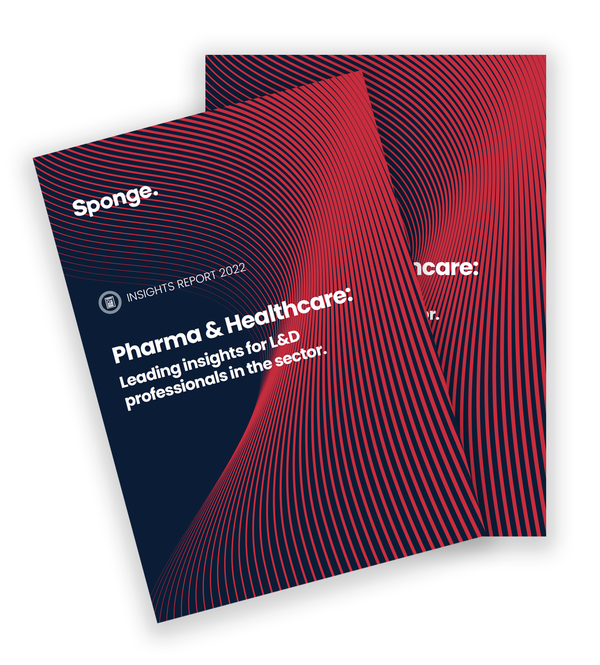To accompany the first of five industry specific reports exploring the emerging learning technologies transforming workplace learning, this blog looks at the top three sector-specific priorities for L&D in the pharmaceutical & healthcare industry.
Setting the scene.
COVID-19 affected all industries through supply chain issues, changing working patterns, and the acceleration of digital transformation. However, out of all the core business sectors, none have a more complicated relationship with the pandemic as the pharmaceutical industry.
However, the continuing threat of COVID-19 and other ‘business as usual’ challenges, mean that pharma still faces significant obstacles that need to be overcome.
Having grown 225% between 2001 and 2020, and boomed during the pandemic, the market forecast looks good, as pharma responds to ageing populations, complex health challenges, and enters new markets. How will the industry adapt to technological change? How will it upskill its workers? And how will it use data to aid both personalisation and compliance?
We have assembled the following three insights to aid key L&D decision makers within the pharma sector. They are summarised below and explored in more detail in the insight report.
For a deeper analysis of the insights we discuss, take a look at our first industry-specific industry report.
In this report, we will cover:
- An analysis of the top 3 L&D priorities for pharma & healthcare.
- Key considerations when addressing these priority areas.
- How to set your digital learning up for success.
L&D Insights for Pharma & Healthcare 2022

Insight One: Scalable skills growth is a priority to keep pace with sector growth.
Over the past few decades, we have seen a move from globalisation to localisation in the pharmaceutical industry, with organisations moving into emerging markets to cut costs. More recently, we have seen a hybrid version develop (glocalisation), whereby pharma companies adapt their service offering to meet local cultures and customs.
COVID-19 has been a major catalyst for this transition to glocalisation by forcing organisations to move to virtual sales. On the ground, this has broadened both the geographical reach and number of interactions that pharma sales reps have with healthcare professionals (HCPs).
A key priority for L&D in 2022 is to deliver content to enable sales reps to gain the soft skills required to better serve their virtual contacts. When this learning can be delivered in the form of bitesize content, it can be delivered in the flow of work, during busy sales schedules.
Insight Two: The success of tech advancements and new hiring drives will depend upon data-driven and self-directed learning.
Both the rise in xAPI statements and technological change, more broadly, is leading to a spike in data personalisation within the pharmaceutical industry. According to the report from global consultancy Roland Berger, pharma is going digital ‘faster than expected’. For example, it is estimated that AI could replace 20% of medical services by 2025.
Data personalisation is vital for supporting the rapidly growing personalised medicine market (estimated to be worth $5.7 trillion USD by 2030), as well as supporting the learning needs of individuals within the industry. Currently, however, data is not being fully utilised by the sector.
To combat this, L&D practitioners should encourage the use of Learning Record Stores (LRSs). As Sponge’s work with global pharmaceutical organisation Lundbeck shows, LRSs allow for critical risks within the business to be identified, by drilling down into the skills and skill gaps of individual employees.
Insight Three: Meeting regulatory standards whilst scaling requires a data-driven approach to compliance training.
Compliance plays a vital role in the heavily regulated pharmaceutical industry. However, as with data personalisation, many players within the sector are not using data analytics to their full potential – such as connecting compliance to other metrics such as ROI and KPIs. In 2022, it is vital that L&D goes from simply collecting insights derived from individual and group performances in compliance learning, to connecting and reporting them to the wider business.
Although essential, connecting compliance to the wider business strategy does create additional challenges. The collected data will come from a range of sources, and it is important to take a ‘less is more’ approach to the number of metrics you measure. The sheer volume of data and potential for analysis can lead to an organisation ‘drowning in data’ according to Sponge’s Head of Learning Solutions, Liz Hardwell. It is important to take an objective view of the data that you collect.
Given the focus on compliance and need for regulation, L&D will always play a major role in the pharmaceutical industry. Now, with the industry shifting both geographically and technologically, L&D must also respond to meet pharma’s changing situation, while serving its day-to-day requirements.
How can Sponge help?
At Sponge, we can help solve these challenges through our team of Learning Experience Consultants (LEXCs), who work collaboratively with organisations to enable them to take a data-driven approach to their compliance learning.
Author: Kelly Bradley, Head of Global Accounts, Sponge
Download Report
Fill in your details to download a copy of our insights report.

